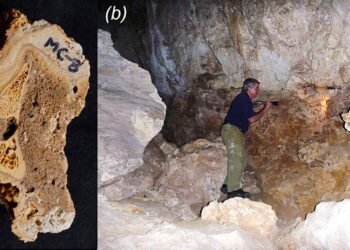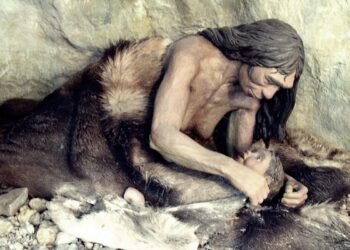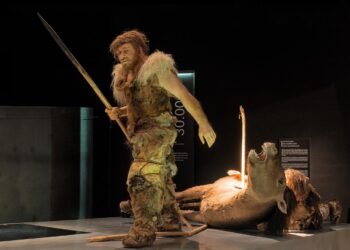A team of paleontologists from the University of Toronto Mississauga has uncovered a remarkable almost 300-million-year-old fragment of fossilized reptile skin in the Richards Spur cave system in Oklahoma.
This ancient skin, resembling that of modern crocodiles, is more than 20 million years older than any previously described skin fossils from animals, according to a study published in Current Biology.
The discovery is particularly significant as it addresses a longstanding gap in paleontological research regarding the adaptation of animal skin to the transition from water to land during the late Paleozoic Era.
Ethan Mooney, the lead author and a paleontology master’s student at the University of Toronto, emphasized the challenges in studying the evolution of this crucial organ after death.
The fossilized skin, about the size of a fingernail and as thin as a human hair, was found in the limestone caves of Richards Spur, known for their diverse and well-preserved fossils from the Paleozoic.

The caves, once filled with petroleum and tar from the nearby Woodford Shale, created ideal conditions for fossil preservation, slowing decomposition and protecting the fossils from decay. This unique environment, combined with low oxygen levels, facilitated the preservation of soft tissue, an exceptionally rare occurrence in paleontology.
Tea Maho, a U of T biologist involved in the study, initially mistook the delicate specks for bone fragments, but microscopic analysis revealed an extraordinarily well-preserved reptilian skin with a 3D structure. The skin, identified as the outermost layer or epidermis, exhibited a complex structure with individual bands of folded scales separated by a flexible “hinge” region, allowing for growth and movement. This finding challenges previous assumptions about the evolution of reptile scales, suggesting that their structure has remained virtually unchanged for millions of years.
The researchers believe the skin belonged to Captorhinus aguti, a lizard-like reptile common in the region during the Permian Period. Despite the absence of a associated skeleton, the wrinkled, pebble-like texture of the skin closely resembles that of crocodiles, providing valuable evidence of early reptilian characteristics.
This groundbreaking discovery, estimated to be between 286 and 289 million years old, offers insights into the history and evolution of amniotes—reptile-like land animals predating dinosaurs. The fossilized skin’s scale patterns and internal structures closely resemble those of modern crocodiles, providing a glimpse into the adaptation of animals during the late Paleozoic Era.
Roger Benson, a paleontologist and curator at the American Museum of Natural History, praised the study’s methods and assumptions, affirming that the evidence aligns with an early Permian age. He said that it represents the first chapter of higher vertebrate evolution, marking a pivotal moment in the transition from aquatic to terrestrial life.
Mooney underscored the importance of the skin’s resemblance to modern reptiles and emphasized its critical role in adapting to life on land.






















